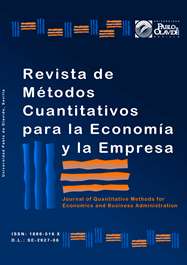A Methodology to Elaborate Laws of Possibilities in the Retreat of a Client: An Application to the Dress Sector
DOI:
https://doi.org/10.46661/revmetodoscuanteconempresa.2343Keywords:
incertidumbre, números borrosos, subconjunto aleatorio borroso, duración del cliente, distancia de Hamming, método heurístico, uncertainty, fuzzy numbers, fuzzy random subset, customer permanence, Hamming distance, heuristic methodAbstract
The current work tests, in the dress sector in the center of the country, a methodology based in the theory of uncertainty and the fuzzy subsets, in order to build laws of possibilities for the retreat of clients only with the subjective opinion given by experts. The contribution of the present work allows to obtain an alternative path when it is not possible to get the required information by the models identified in the literature based in principles derived of the random laws even from heuristic methods. The results show the utility of fuzzy concepts in a problem where the uncertainty in relation to the permanence of the client is evident and allows to obtain a valuable element (time), when the Customer Lifetime Value (CLV) is required to be measured in the field of uncertainty.
Downloads
References
Abe, M. (2009). "Counting your customers" one by one: A hierarchical Bayes extension to the Pareto/NBD model. Marketing Science, 28(3), 541-553.
Fader, P.S., Hardie, B.G.S. & Lee, K.L. (2005). "Counting your customers" the easy way: An alternative to the Pareto/NBD model. Marketing Science, 24(2), 275-284.
Fader, P.S., Hardie, B.S. & Shang, J. (2010). Customer-Base Analysis in a Discrete-Time Noncontractual Setting. Marketing Science, 29(6), 1086-1108.
Figini, S. (2010). Penalized models to estimate customer survival. Statistical Methods & Applications, 19(1), 141-150.
Gil Aluja, J. (1996). Lances y desventuras del nuevo paradigma de la teoría de la decisión. Proceedings del III Congreso de la Sociedad Internacional para la Gestión y Economía Fuzzy, Buenos Aires.
Gil Aluja, J. (2002). Introducción de la Teoría de la incertidumbre en la gestión de empresas. Vigo: Editorial Milladoiro.
Gil Lafuente, J. (1997). Marketing para el nuevo milenio: Nuevas técnicas para la gestión comercial en la incertidumbre. Madrid: Ediciones Pirámide.
Kaufmann, A. & Gil-Aluja, J. (1987). Técnicas operativas de gestión para el tratamiento de la incertidumbre. Barcelona: Editorial Hispano Europea.
Kaufmann, A. & Gil-Aluja, J. (1990). Las matemáticas del azar y de la incertidumbre: Elementos básicos para su aplicación en economía. Madrid: Centro de Estudios Ramon Areces.
Kaufmann, A. & Gil-Aluja, J. (1992). Técnicas de gestión de empresa: Previsiones, decisiones y estrategias. Madrid: Ediciones Pirámide.
Lu, J. (2003). Modeling customer lifetime value using survival analysis—an application in the telecommunications industry. Proceedings of the 28th Annual SAS Users Group International Conference. Cary, NC: SAS Institute Inc, Paper 120-28. Disponible en http://www2.sas.com/proceedings/sugi28/120-28.pdf.
Neslin, S., Gupta, S., Kamakura, W., Lu, J. & Mason, C. (2006). Defection Detection: Measuring and Undestanding the Predictive Accuracy of Customer Churn Models. Journal of Marketing Research, 43(2), 204-211.
Reinartz, W. & Kumar, V. (2000). On the profitability of long-life customers in a noncontractual setting: An empirical investigation and implications for marketing. Journal of Marketing, 64(4), 17-35.
Reinartz, W. & Kumar, V. (2003), The Impact of Customer Relationship Characteristics on Profitable Lifetime Duration. Journal of Marketing, 67(1), 77-99.
Schmittlein, D., Morrison, D. & Colombo, R. (1987). Counting your customers: Who are they and What will they do next? Management Science, 33(1), 1-24.
Schmittlein, D.C. & Peterson, R.A. (1994). Customer Base Analysis: An Industrial Purchase Process Application. Marketing Science, 13(1), 41-67.
Tamaddoni Jahromi, A., Sepehri, M. M., Teimourpour, B. & Choobdar, S. (2010). Modeling customer churn in a non-contractual setting: the case of telecommunications service providers. Journal of Strategic Marketing, 18(7), 587-598.
Wübben, M. & Von Wangenheim, F. (2006). Predicting Customer Lifetime Duration And Future Purchase Levels: Simple Heuristics vs. Complex Models. En J.L. Johnson & J. Hulland (eds.) AMA Winter Educators' Conference: Marketing Theory and Applications, 17, 83-84.
Downloads
Published
How to Cite
Issue
Section
License
Copyright (c) 2016 Journal of Quantitative Methods for Economics and Business Administration

This work is licensed under a Creative Commons Attribution-ShareAlike 4.0 International License.
Submission of manuscripts implies that the work described has not been published before (except in the form of an abstract or as part of thesis), that it is not under consideration for publication elsewhere and that, in case of acceptance, the authors agree to automatic transfer of the copyright to the Journal for its publication and dissemination. Authors retain the authors' right to use and share the article according to a personal or instutional use or scholarly sharing purposes; in addition, they retain patent, trademark and other intellectual property rights (including research data).
All the articles are published in the Journal under the Creative Commons license CC-BY-SA (Attribution-ShareAlike). It is allowed a commercial use of the work (always including the author attribution) and other derivative works, which must be released under the same license as the original work.
Up to Volume 21, this Journal has been licensing the articles under the Creative Commons license CC-BY-SA 3.0 ES. Starting from Volume 22, the Creative Commons license CC-BY-SA 4.0 is used.










